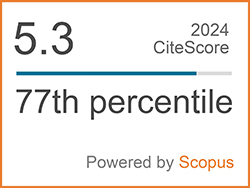Tin Powder Preparation by Electrodeposition of Tin Chloride in a Choline Chloride-Ethylene Glycol Deep Eutectic Solvent
Abstract
Keywords
[1] A. J. Diaz, D. Ma, A. Zinn, and P. O. Quintero, “Tin nanoparticle-based solder paste for low temperature processing,” Journal of Microelectronics and Electronic Packaging, vol. 10, no. 4, pp. 129–137, 2013, doi: 10.4071/imaps.386.
[2] Y. Li, M. Bu, C. Mu, and C. Yang, “Fabricating lithiophilic Sn nanolayer via vacuum evaporation coating for anode-free lithium metal battery,” Materials Letters, vol. 355, 2024, Art. no. 135449, doi: 10.1016/j.matlet.2023.135449.
[3] L. Yu, C. Miao, S. Nie, M. Wen, J. Wang, Y. Tan, and W. Xiao, “Feasible preparation of Cu6Sn5 alloy thin-film anode materials for lithium-ion batteries from waste printed circuit boards by electrodeposition,” Solid State Ionics, vol. 364, 2021, Art. no. 115625, doi: 10.1016/j.ssi.2021.115625.
[4] N. Banno, “Low-temperature superconductors: Nb3Sn, Nb3Al, and NbTi,” Superconductivity, vol. 6, Jun. 2023, Art. no. 100047, doi: 10.1016/j.supcon.2023.100047.
[5] A. Nassef and M. El-Hadek, “Microstructure and mechanical behavior of hot pressed Cu-Sn powder alloys,” Advances in Materials Science and Engineering, vol. 2016, no. 1, 2016, Art. no. 9796169, doi: 10.1155/2016/9796169.
[6] T. E. Abioye, H. Zuhailawati, M. A. I. Azlan, and A. S. Anasyida, “Effects of SiC additions on the microstructure, compressive strength and wear resistance of Sn-Sb-Cu bearing alloy formed via powder metallurgy,” Journal of Materials Research Technology, vol. 9, no. 6, pp. 13196–13205, 2020, doi: 10.1016/j.jmrt.2020.08.102.
[7] Özgünn, K. Aslantaş, and A. Ercetin, “Powder metallurgy mg-sn alloys: Production and characterization,” Scientia Iranica, vol. 27, no. 3B, pp. 1255–1265, 2020, doi: 10.24200/SCI.2019.50212.1578.
[8] X. Zhou, H. Fang, T. Yuan, and R. Li, “Effect of slight Sn modification on mechanical properties and corrosion behavior of Ti- (2–4 wt%) Mn alloys fabricated via powder metallurgy,” Materials Characterization, vol. 203, 2023, Art. no. 113068, doi: 10.1016/j.matchar. 2023.113068.
[9] J. Sun, K. Yamanaka, and S. Zhou, “Adhesion mechanism of cold-sprayed Sn coatings on carbon fiber reinforced plastics,” Applied Surface Science, vol. 579, 2022, Art. no. 151873, doi: 10.1016/j.apsusc.2021.151873.
[10] E. Bestek, “Powder metallurgy processes and making metal powder,” Materials and Manufacturing Technology, pp. 2–5, 2020, doi: 10.13140/RG.2.2.21469.84967.
[11] P. Luo, B. Sun, J. Li, M. Lu, L. Wang, and J. Jiang, “Effect of Antimony (III) on tin recovery by cementation on zinc powder under alkaline conditions,” International Journal of Electrochemical Science, vol. 14, no. 3, pp. 2621–2630, 2019, doi: 10.20964/2019.03.70.
[12] Y.W. Kim, K.C. Choi, Y. Chung, E. Choi, and T Nam, “Microstructure and martensitic transformation characteristics of gas-atomized Ti–Ni–Cu powders,” Journal of Alloys and Compounds, vol. 577, pp. S227–S231, 2013, doi: 10.1016/j.jallcom.2012.02.041
[13] G. Rimaszeki, T. Kulcsar, and T. Kekesi, “Investigation and optimization of tin electrorefining in hydrochloric acid solutions”, Journal of Applied Electrochemistry, vol. 42, no. 8, pp. 573–584, 2012, doi: 10.1007/s10800-012-0433-1.
[14] J. Lee, J. Kim, B. Chang, H. Kim, and S. Park, “Effects of Ethoxylated α-Naphtholsulfonic acid on tin electroplating at iron electrodes,” Journal of The Electrochemical Society, vol. 151, no. 5, p. C333, 2004, doi: 10.1149/1.1690289.
[15] S. H. Son, S. C. Park, J. H. Kim, Y. H. Kim, M. S. Lee, and J. W. Ahn, “Study on the electro-refining of tin in acid solution from electronic waste,” Archives of Metallurgy and Materials, vol. 60, no. 2, pp. 1217–1220, 2015, doi: 10.1515/amm-2015-0101.
[16] D. Bilican, J. Fornell, J. Sort, and E. Pellicer, “Electrochemical synthesis of bismuth particles: Tuning particle shape through substrate type within a narrow potential window,” Materials (Basel), vol. 10, no. 1, pp. 1–10, 2017, doi: 10.3390/ma10010043.
[17] L.Tomé, V. Baião, W. Silva, and C. Brett, “Deep eutectic solvents for the production and application of new materials,” Applied Materialstoday, vol. 10, pp. 30–50, 2018, doi: 10.1016/j.apmt.2017.11.005.
[18] M. A. Khan, S. Lee, and M. Sriariyanun, “Deep eutectic solvent as a tailor-made chemicals for pretreatment in a lignocellulose biorefinery,” Applied Science and Engineering Progress, vol. 17, no. 3, pp. 1–4, 2024, doi: 10.14416/j.asep. 2024.03.003.
[19] A. P. Abbott, “Deep eutectic solvents and their application in electrochemistry,” Current Opinion in Green and Sustainable Chemistry, vol. 36, 2022, Art. no. 100649, doi: 10.1016/ j.cogsc.2022.100649.
[20] B. B. Hansen, S. Spittle, B. Chen, D. Poe, Y. Zhang, J. Klein, A. Horton, L. Adhikari, T. Zelovich, B. Doherty, B. Gurkan, E. Maginn, A. Ragauskas, M. Dadmun, T. Zawodzinski, G. Baker, M. Tuckerman, R. Savinell, and J. Sangoro, “Deep eutectic solvents: A review of fundamentals and applications,” Chemical Reviews, vol. 121, no. 3, pp. 1232–1285, 2021, doi: 10.1021/acs.chemrev.0c00385.
[21] A. M. J. Popescu, V. Constantin, M. Olteanu, O. Demidenko, and K. Yanushkevich, “Obtaining and structural characterization of the electrodeposited metallic copper from ionic liquids,” Revista de Chimie, vol. 62, no. 6, pp. 626–632, 2011.
[22] N. G. Sousa, C. P. Sousa, O. S. Campos, P. de Lima-Neto, and A. N. Correia, “One-step preparation of silver electrodeposits from non-aqueous solvents,” Journal of Molecular Liquids, vol. 288, 2019, Art. no. 111091, doi: 10.1016/j.molliq.2019.111091.
[23] J. Cheng, C. Zheng, K. Xu, Y. Zhu, Y. Song, and C. Jing, “Sequential separation of critical metals from lithium-ion batteries based on deep eutectic solvent and electrodeposition,” Journal of Hazardous Materials, vol. 465, 2024, Art. no. 133157, doi: 10.1016/j.jhazmat.2023.133157.
[24] J. Bu, J. Ru, Z. Wang, Y. Hua, C. Xu, Y. Zhang, and Y. Wang, “Controllable preparation of antimony powders by electrodeposition in choline chloride-ethylene glycol,” Advanced Powder Technology, vol. 30, no. 12, pp. 2859–2867, 2019, doi: 10.1016/j.apt.2019.06.027.
[25] E. Barrado, S. García, J. A. Rodríguez, and Y. Castrillejo, “Electrodeposition of indium on W and Cu electrodes in the deep eutectic solvent choline chloride-ethylene glycol (1:2),” Journal of Electroanalytical Chemistry, vol. 823, pp. 106–120, 2018, doi: 10.1016/j.jelechem.2018. 06.004.
[26] A. Bakkar and V. Neubert, “Recycling of cupola furnace dust: Extraction and electrodeposition of zinc in deep eutectic solvents,” Journal of Alloys and Compounds, vol. 771, pp. 424–432, 2019, doi: 10.1016/j.jallcom.2018.08.246.
[27] J. C. Pereira, L. D. Santos, A. A. Alcanfor, H. B. D. Anna, F. X. Feitosa, O. S. Campos, A. N. Correira, P. N. S. Casciano, and P. D. Neto, “Effects of electrodeposition parameters on corrosion resistance of ZnSn coatings on carbon steel obtained from eutectic mixture based on choline chloride and ethylene glycol,” Journal of Alloys and Compounds, vol. 886, 2021, Art. no. 161159, doi: 10.1016/j.jallcom.2021.161159.
[28] Z. Wang, T. Wu, J. Ru, Y. Hua, J. Bu, and D. Wang, “Eco-friendly preparation of nanocrystalline Fe-Cr alloy coating by electrodeposition in deep eutectic solvent without any additives for anti-corrosion”, Surface and Coatings Technology, vol. 406, 2021, Art. no. 126636, doi: 10.1016/j.surfcoat. 2020.126636.
[29] R. Subagja, I. Setiawan, A. R. Rhamdani, and J. Irawan, “Effect of technological parameters on the electrowinning of cobalt from Cobalt(II) chloride solutions,” International Journal of Electrochemical Science, vol. 17, pp. 1–18, 2022, doi: 10.20964/2022.09.66.
[30] E. Ciro, A. Dell’Era, M. Pasquali, and C. Lupi, “Indium electrowinning study from sulfate aqueous solution using different metal cathodes,” Journal of Environmental Chemical Engineering, vol. 8, no. 2, 2020, Art. no. 103688, doi: 10.1016/j.jece.2020.103688.
[31] A. J. Bard, Electrochemical Methods: Fundamentals and Applications, 2nd ed. New York: John Wiley & Sons, 2001.
[32] S. Rosoiu, S. Costovivi, C. Moise, A. Petica, L. Anicai, T. Visan, and M. Enachescu, “Electrodeposition of ternary Sn-Cu-Ni alloys as lead-free solders using deep eutectic solvents,” Electrochiica Acta, vol. 398, 2021, Art. no. 139339, doi: 10.1016/j.electacta.2021.139339.
[33] L. Vieira, J. Burt, P. W. Richardson, D. Schloffer, D. Fuchs, A. Moser, P. N. Bartlett, G. Reid, and B. Gollas, “Tin, bismuth, and tin–bismuth alloy electrodeposition from chlorometalate salts in deep eutectic solvents,” ChemistryOpen, vol. 6, no. 3, pp. 393–401, 2017, doi: 10.1002/open.201700045.
[34] X. Cao, L. Xu, Y. Shi, Y. Wang, and X. Xue, “Electrochemical behavior and electrodeposition of cobalt from choline chloride-urea deep eutectic solvent,” Electrochimica Acta, vol. 295, pp. 550–557, 2019, doi: 10.1016/j.electacta. 2018.10.163.
[35] A. Al-Murshedi, H. F. Alesary, and R. Al-Hadrawi, “Thermophysical properties in deep eutectic solvents with/without water,” Journal of Physics: Conference Series, vol. 1294, no. 5, 2019, doi: 10.1088/1742-6596/1294/5/052041.
[36] X. Cao, L. Xu, C. Wang, S. Li, D. Wu, Y. Shi, F. Liu, and X. Xue, “Electrochemical behavior and electrodeposition of Sn coating from choline chloride–urea deep eutectic solvents,” Coatings, vol. 10, no. 12, pp. 1–10, 2020, doi: 10.3390/ coatings10121154.
[37] J. Huang, W. Wang, Q. Xiang, S. Xin, P. Wang, N. Mitsuzaki, and Z. Chen, “Effect of deposition potential on electrodeposition of Sn-Ag-Cu ternary alloy solderable coating in deep eutectic solvent,” Journal of Electroanalytical Chemistry, vol. 943, 2023, doi: 10.1016/ j.jelechem.2023.117613.
[38] C. C. Miller, “The stokes einstein law for diffusion in solution,” in Proceedings of the Royal Society A: Mathematical, Physical, And Engineering Sciences, pp. 724–749, 1924.
[39] Y. Karar, S. Boudinar, A. Kadri, J. C. Leprêtre, N. Benbrahim, and E. Chaînet, “Ammonium chloride effects on bismuth electrodeposition in a choline chloride-urea deep eutectic solvent,” Electrochimica Acta, vol. 367, 2021, Art. no. 137481, doi: 10.1016/j.electacta.2020.137481.
[40] L. Zhou, Y. Dai, H. Zhang, Y. Jia, J. Zhang, and C. Li, “Nucleation and growth of bismuth electrodeposition from alkaline electrolyte,” Bulletin of the Korean Chemical Society, vol. 33, no. 5, pp. 1541–1546, 2012, doi: 10.5012/bkcs. 2012.33.5.1541.
[41] T. Kulcsar, G. B. Toth, and T. Kekesi, “Complex evaluation and development of electrolytic tin refining in acidic chloride media for processing tin-based scrap from lead-free soldering,” Transactions of the Institutions of Mining and Metallurgy: Section C Mineral Processing and Extractive Metallurgy, vol. 125, no. 4, pp. 228–237, 2016, doi: 10.1080/03719553.2016.1206693.
[42] A. V. Zaikovskii, A. A. Iurchenkova, D. V. Kozlachkov, and E. O. Fedorovskaya, “Effects of tin on the morphological and electrochemical properties of arc-discharge nanomaterials,” Journal of the Minerals, Metals & Materials Society, vol. 73, no. 3, pp. 847–855, 2021, doi: 10.1007/s11837-020-04556-z.
DOI: 10.14416/j.asep.2025.05.001
Refbacks
- There are currently no refbacks.
 Applied Science and Engineering Progress
Applied Science and Engineering Progress







